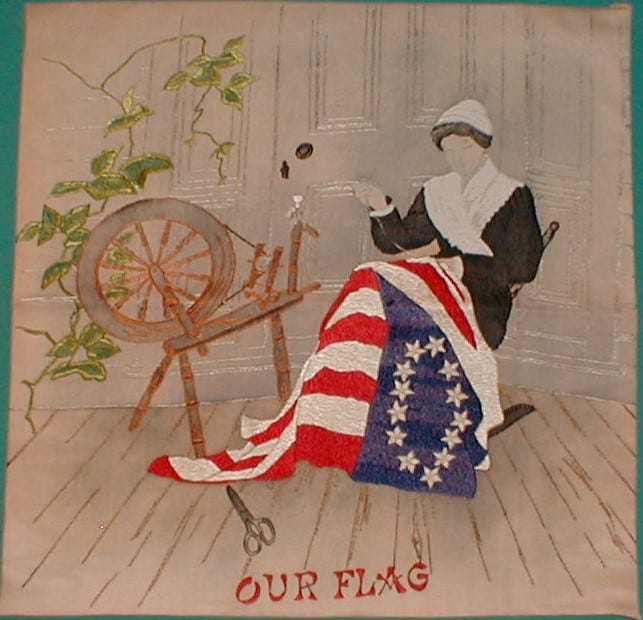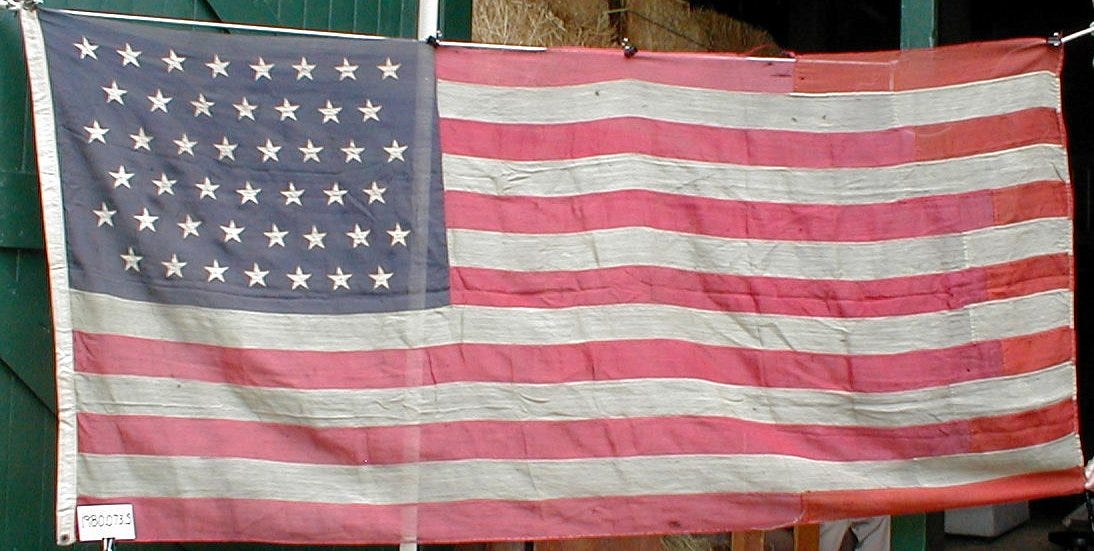Hello and welcome if you’re new to History Buzz! If you enjoy this story, please share History Buzz with fellow history buffs, like, and comment. To have History Buzz stories sent directly to your inbox, you can subscribe to the newsletter—for free or for a few dollars per month. You can also donate to the History Center. Your paid subscription helps make the research and writing behind History Buzz possible. Thanks for reading!
You’re a grand old flag…
At the beginning of the American Revolution, there was no uniform flag. The colonies and militias used many different flags. The Continental Navy used the “Don’t Tread on Me” flag designed with a rattlesnake across it. The Continental Army used different designs. On New Year’s Day 1776, a Continental Congress resolution placed all American forces under George Washington's control. At that time, George Washington was commanding the Continental Army surrounding Boston to regain the city from the British. Washington had the Grand Union flag raised at Prospect Hill in Charleston. The Grand Union flag had 13 red and white stripes and the Union Jack in the upper left corner. Apparently, the Boston Loyalists thought that the Grand Union flag was an indication that the Continentals were surrendering.
A new flag for the emerging nation was needed.
It wasn’t until June 14th, 1777, that the Continental Congress passed a resolution to establish an official national flag. The first Flag Act “Resolved, that the flag of the United States be made of thirteen stripes, alternate red and white; that the union be thirteen stars, white in a blue field, representing a new Constellation."
Who designed and who sewed the first US flag is a mix of fact and legend. Francis Hopkinson, of Philadelphia, representing New Jersey in the Continental Congress, and a signer of the Declaration of Independence, may have suggested the design of stars in a circle as a constellation. School children learn of Betsy Ross as the seamstress of the first flag. An accomplished seamstress and upholster living in Philadelphia, she did sew one of the first American flags. However nothing in George Washington’s records, nor records in the Library of Congress, substantiate the family legend that her flag was the first.
The 1777 Flag Resolution established the color and number of the stripes and the stars. It did not set whether the stars should have 5 or 6 points and how they should be positioned on the blue field, nor which of the 13 stripes would be red or white. It was left up to flag maker.
You’re a high-flying flag…
Many resolutions followed to establish a uniform design. A 1794 act established that in May 1795, the flag could have 15 stripes and 15 stars. The “Star Spangled Flag” that was flown over Fort McHenry during the War of 1812 and that inspired Francis Scott Key to the write of the poem which became our national anthem, has 15 stripes.
One of America’s most cherished flags, it was sewn by Mary Pickersgill, of Baltimore MD, an experienced signal flag and naval flag maker. In 1813, she was contracted to sew two American flags for Fort McHenry. One was a small-sized flag to be flown in bad weather. The other was a 30 by 40 foot flag to be flown high above the fort. She was helped by her daughter Caroline; nieces Eliza Young and Margaret Young; and Grace Wisher, an African-American indentured servant. The Star Spangled Banner now hangs in an honored place in the Smithsonian National Museum of American History in Washington, D.C.
You’re the emblem of….
Though it wasn’t stated in any resolution the symbolism of the flag’s colors was suggested by Charles Thomson, a Patriot leader and secretary of the Continental Congresses. When he was describing the design of the Great Seal of the United States wrote: “White signifies purity and innocence, Red, hardiness & valour, and Blue signifies vigilence [sic], perseverence [sic] & justice.”
It wasn’t until 1818 that the standard of 13 stripes was set and that each state would have one star. Policy was to add the star of a new state on July 4th of the year in which a state gained statehood or the following year depending on when a state was admitted. Flag makers were busy between 1818 and 1912 when 26 states gained statehood, resulting in the flag being revised 21 times.
The standardization of proportion, number of stripes and when a star was added, benefited the flag manufacturers. It also makes establishing the date of a historic flag a bit easier. We know that the 45-star flag sewn by Abby Locke Thomson had to be made after January 4, 1896, when Utah, the 45th state, was admitted to the Union. The next state to be admitted was Oklahoma, in November of 1907. The 46th star was added the following July.
In 1912, President Howard Taft signed an Executive Order that set the proportions of the flag and set the stars to be arranged in six horizontal rows of eight stars each, and a single point of each star should point upward. Subsequent Executive Order by Eisenhower in January 1959 and August 1959 modified the rows of stars to accommodate new states. The United States flag hasn’t changed since July 4th 1960 when Hawaii was added.
Keep your eye on the grand old Flag!
Have a Happy 4th of July!
Thanks for reading.
You can send your favorite 4th of July memories, stories, and comments by clicking below or directly to me at mhelmers@andoverhistoryandculture.org
Resources
Andover Center for History and Culture Collection
Smithsonian National Museum of American History
Flag Facts - Chart of years stars were added
History of Old Glory
A nod to George M. Cohan, lyricist of “You’re a Grand Old Flag”










the Grand Union flag was an alteration of the British Navel Jack, a red flag with the King's colours (Union Jack) in the canton. it would have been the most visible British flag in the colonies. to it were added 6 white stripes which created 13 red & white stripes with the King's Colours in the canton.